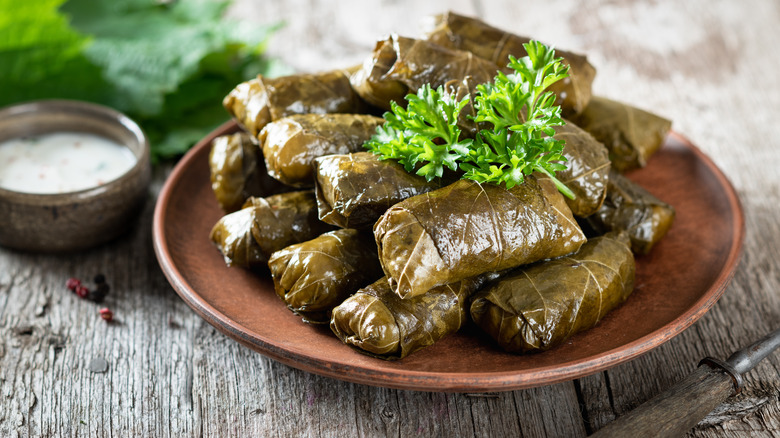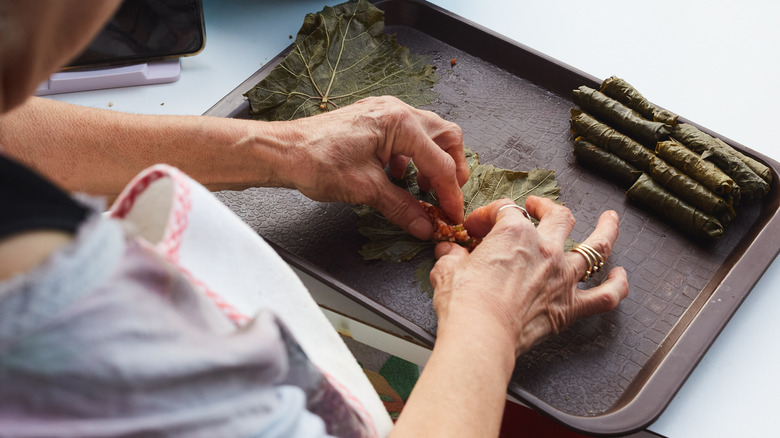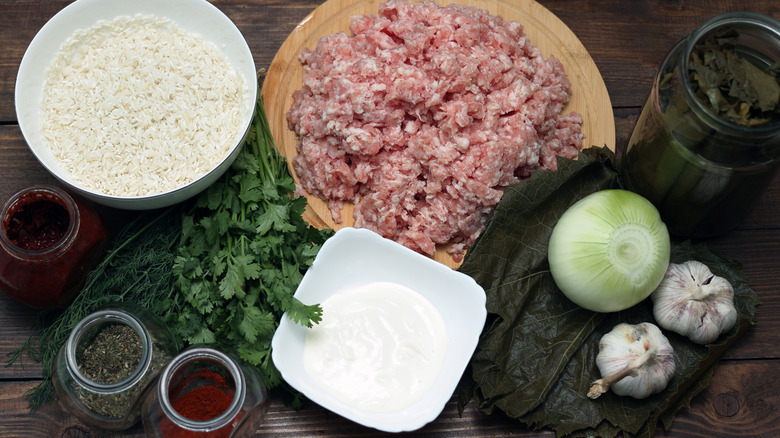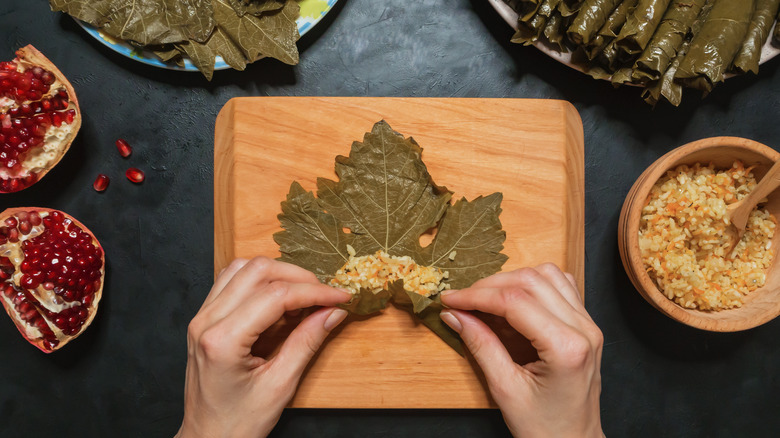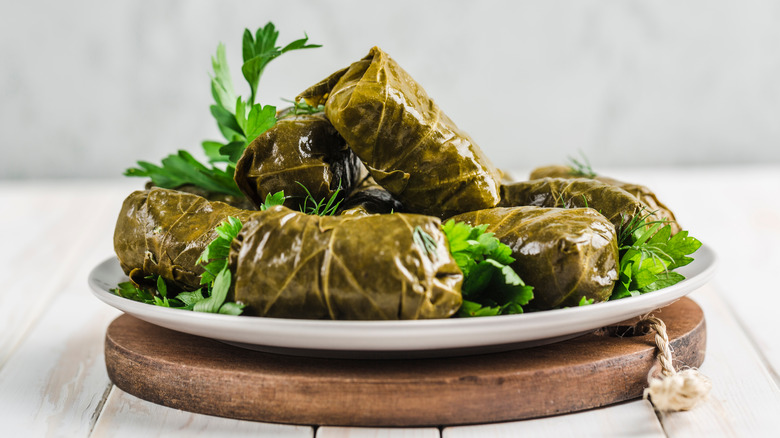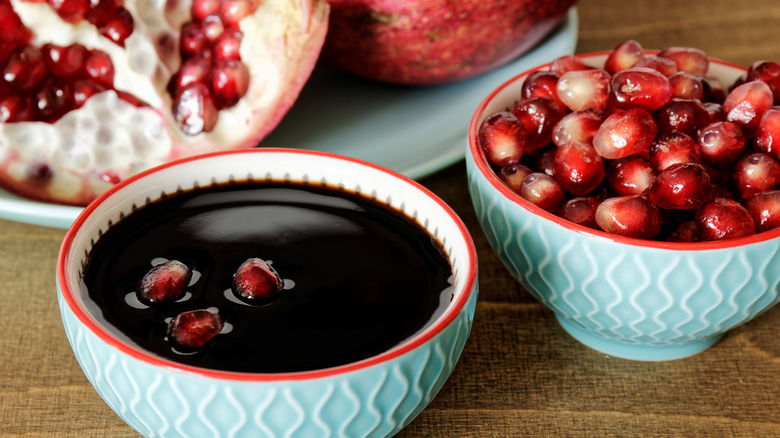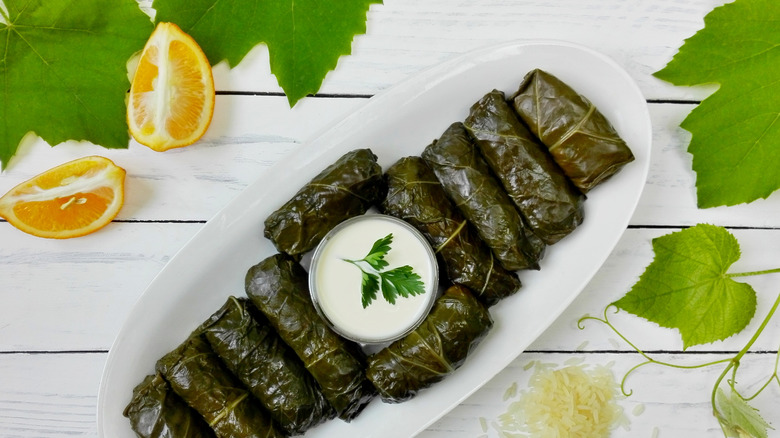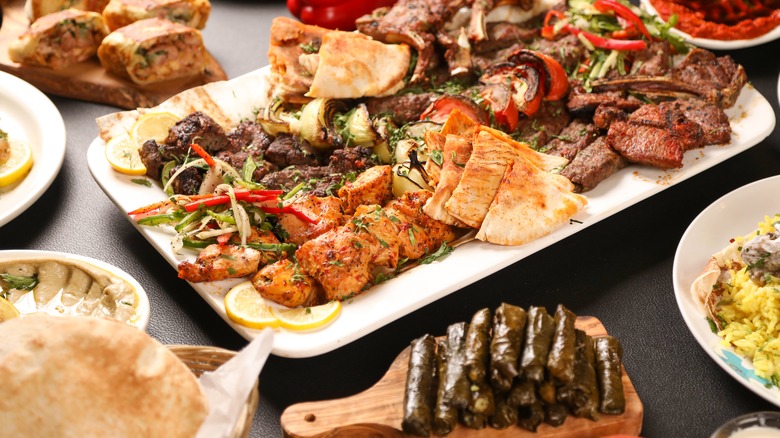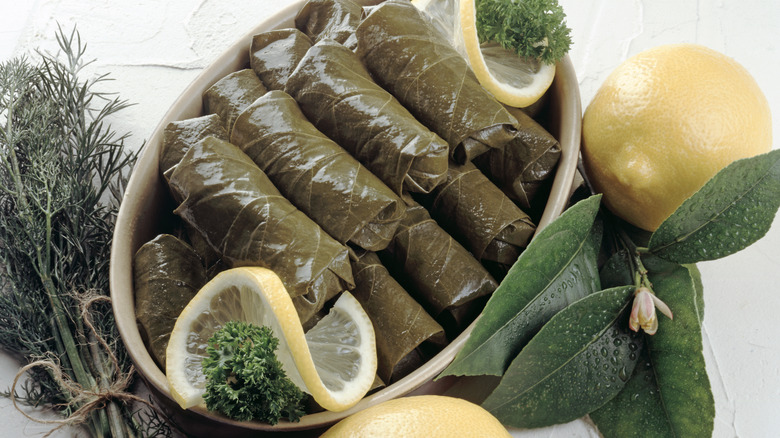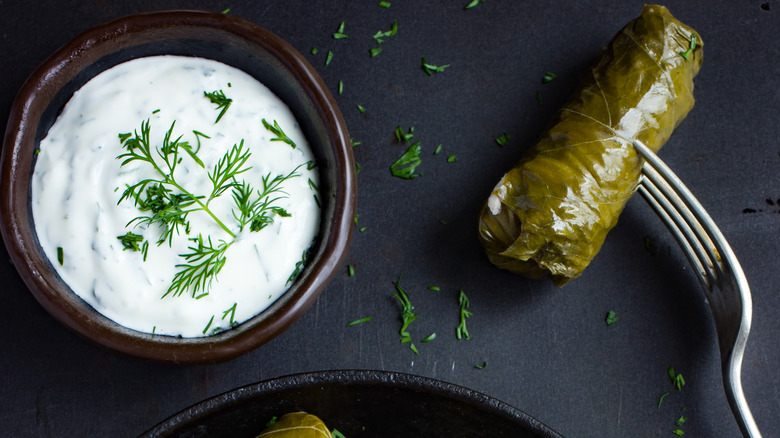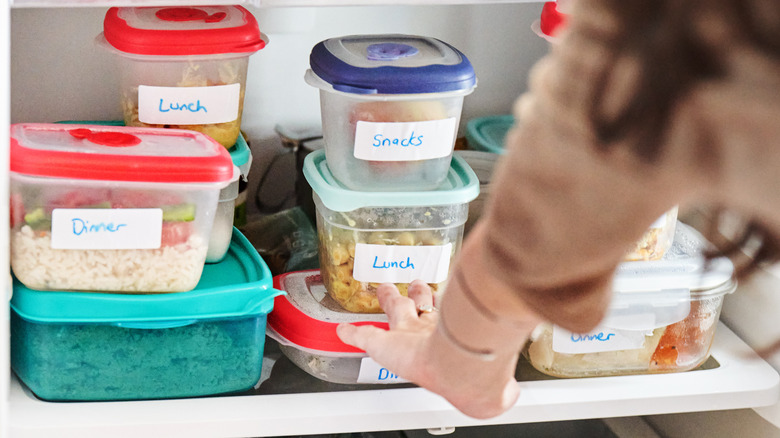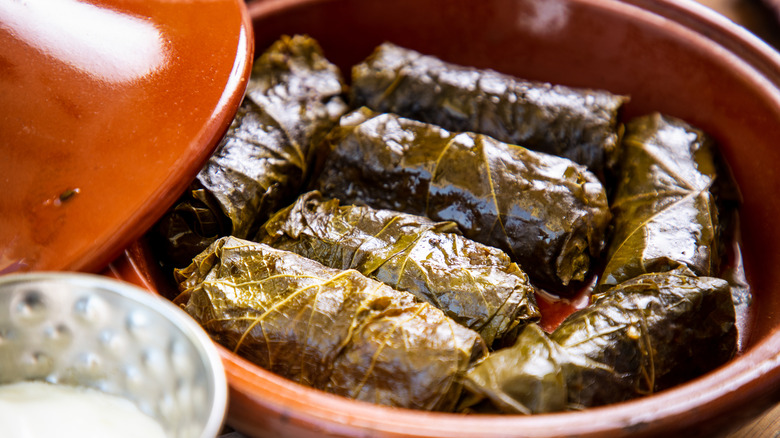Your Ultimate Guide To Canned Dolmas
Unless you know your Mediterranean and Middle Eastern cuisine well, you may have never heard of dolmas. Or perhaps you've seen them in the canned food aisle of your grocery store and never given them a second thought. If you're already a fan of the dish, then you know that they come in all different forms with one major consistency: they are tender, edible grapes leaves made into the perfect casing for rice, meats, spices, and other goodies. Dolmas, also known as dolmades, are one of the top Greek dishes you need to try — but the dish no longer belongs solely to the Greeks. Stuffed grape leaves can be found in the Balkans, Turkey, and Central Eurasia. However, it's rare to find them made fresh in the United States, so it's recommended to head for the canned goods or imports section of your grocery store.
Even if you've never worked with or eaten them before, canned dolmas are easy to pair, serve, and fall in love with. There are a few methods that are commonly suggested for choosing a flavorful can of dolmas, and it's good to align these with your personal preferences. Along with selecting good dolmas, there are plenty of ways you can enhance the overall flavor outside the can, including toppings and pairings. That said, dolmas are imported from a region of the world with distinct flavors; we recommend taking a page from the recipe books of the many cuisines that eat them.
Dolmas means stuffed
When we picture dolmas, we often imagine a tender grape leaf wrapped and stuffed with rice and spices. And that's not incorrect. However, the term has quite a bit more reach than that, and although our typical, modern dolmas might have a more consistent look to them, that hasn't always been the case. Originally, they were not exclusively made with grape leaves but referred to any fruit or vegetable stuffed with savory ingredients. This could mean that peppers, dates, or even fig leaves could be used as the casing.
The word dolmas directly translates to "stuffed" in Turkish. However, today when we purchase or make dolmas, it's most likely you'll find them with the classic grape leaf exterior. This is especially true for canned dolmas found in grocery stores in the United States, so if you're looking to purchase a can, there won't be any major surprises.
Today dolmas typically have certain ingredients
Although the name dolmas has been used to describe a variety of stuffed garden vegetables, it's safe to assume the modern canned version you're buying from the grocery store is made with a casing of grape leaves. The stuffing can vary greatly depending on the manufacturer; there are some basic ingredients you can consistently expect. However, if you have a food allergy, aversion, or you're following a certain diet, it's never safe to assume that all dolmas have simple or minimal ingredients, so flip that can over and read through the ingredients list before indulging.
Your basic dolmas will likely contain rice, lemon juice, tomatoes, mint, olive oil, salt, and pepper. Sometimes, cinnamon, green onion, dill, and pine nuts make an appearance. A particularly flavorful version may have rice cooked in vegetable broth. These ingredients are wrapped in fermented grape leaves, about the size of a cigar or slightly larger. Canned dolmas are preserved in olive oil, with rice and leaves having had a chance to soften more so than with fresh dolmas. Think of it as if the stuffed grape leaves have a chance to stew in the olive oil, lemon, and herb infusion. And when it comes to Mediterranean cuisine, it's all about those uplifting, bright flavors and mouthfeel.
The grape leaves are typically fermented
If you've been picturing yourself biting into a tough, fibrous, fresh leaf this whole time, let's relieve some confusion. Although some leaves are tender and delicious when eaten raw, the grape leaf does not make that category. To make grape leaves desirably palatable for dolmas, they are typically fermented but sometimes are pickled. But what's the difference between fermented and pickled foods? Both methods help with preservation, but pickled foods are submerged in an acidic bath, while natural bacteria (probiotics) preserve fermented foods. For reference, pickles are cucumbers that have soaked in vinegar and spices, but sauerkraut is cabbage that has soaked in a bath of its juices and salt to create healthy probiotic bacteria. Either method you choose, the flavor has an acidic outcome.
These grape leaves have been through either the pickling or fermenting process, meaning they are rather tender and flavorful by the time they are used to encase the stuffing. Along with using lemon juice in most dolma recipes, this process makes stuffed grape leaves quite tangy and pungent. It's also why you're not left chewing a fibrous leaf for minutes on end. They become incredibly flexible, which makes the folding and wrapping experience much easier for the manufacturer. It's a win-win situation all around. You can expect most canned dolmas to have fermented grape leaves, but it never hurts to check the ingredients list if you prefer.
Dolmas can be vegan or meat-filled
Although your typical canned dolmas tend to be vegetarian, that's not always the case. Like dumplings, they are made with meat and vegetable fillings, and when it comes to dolmas in particular, the options for stuffings are endless. Vegans and vegetarians should certainly inspect the ingredients label for ground meat, cheese, and eggs.
The rice component of dolmas may be cooked in a chicken broth, and sometimes the stuffing contains grated cheese. Although vegetarians typically give many kinds of cheese the green light, some are made with animal rennet, which means they are not in line with the vegetarian diet. Parmesan cheese, which isn't considered vegetarian, falls into that category. Canned and processed foods sometimes contain surprise ingredients like gelatin or dyes that are not vegan or vegetarian-friendly, and even some unsuspecting foods that seem vegan aren't. So unless you're making it at home, it's always good to look up unfamiliar words on that ingredient list of your canned dolmas.
If you love a good meat dish, look for meat-stuffed dolmas that contain pork, beef, or lamb. It is often ground and cooked with herbs and spices. Unlike a burrito, all of the rice, meat, nuts, and herbs are mixed together before it's rolled up into the casing, so don't expect a strip of sirloin or a thick cut of lamb layered into the rice.
Sometimes specialty ingredients make an appearance
You may notice that dolma recipes vary greatly. Or, if you have the pleasure of enjoying them at a Mediterranean, Balkan, or Middle Eastern restaurant, you might see that they contain a variety of unique ingredients. Travel to the dolma's place of origin, Greece, and you may be lucky enough to find that the options for flavor are even greater. Although your classic canned dolmas will stick to a pretty basic formula, it's possible to find flavors made with specialty goods and accents.
Dolmas that aren't mass-produced sometimes contain nuts, seeds, and dried fruits. Pine nuts, chopped dates, figs, and golden raisins are common and can help balance the savory and biting flavors of the meat, lemon juice, herbs, and fermented leaves. Dried fruits work particularly well when paired with meat-filled dolmas, as meat and fruit make a surprisingly brilliant combination of fatty, chewy mouthfeel and flavor. In addition, dolmas packed in their cans with pomegranate molasses are incredibly desirable and authentic, as pomegranate molasses works best in Middle Eastern dishes. This sweet and puckering taste not only adds flavor but helps to create a smoother, stickier texture. Dolmas studded with pine nuts are buttery soft, while dried fruit is chewy and packed with intense sweetness. This is why checking the ingredient list when purchasing canned dolmas is important. No two companies make them the same way, and you might just come across a gem with something extra.
They can be a snack or a quick meal
So, you've been convinced of their glory and purchased a can of stuffed grape leaves. Now what? Do you put them out as an appetizer? Should you house a can for dinner when you just don't have time to cook? Well, what's inside them, when exactly you should serve dolmas is also a bit ambiguous. This actually makes them quite versatile. They can be eaten as a snack, appetizer, or dinner, so you should always have stuffed grape leaves in your pantry.
If you have company over at the last minute, stuffed grape leaves can be an easy appetizer to get your guests munching. They make a welcome addition to any charcuterie board, and although they are caked in olive oil, they are a reasonable finger food (just be sure to provide napkins). For any Mediterranean or Middle Eastern-style dish, dolmas make for the perfect side dish. Because they are loaded with rice, they can count as starch, which is aesthetically pleasing on a dinner plate. When in doubt, serve them as a main course. Place them in the center of the plate, and enjoy the hearty, stuffed leaves as the main superstars. As a potential main course, dolmas are flavorful enough to handle center stage, though meat and nut-packed varieties are the hardier options.
Pair them with compatible cuisine
When it comes to serving dolmas, you can follow a few simple guidelines to ensure you're matching them with agreeing flavors. First, it's important to note that they can certainly be enjoyed independently, as they are a complete dish. But, if you're looking to include dolmas in dinner or serve them alongside other appetizers or snacks, it's best to stick with a theme. Dolmas tend to pair better with food from the same region of the world, including cuisine from Greece, Turkey, and the Balkans.
Try serving dolmas alongside garlicky Greek baked chicken and tzatziki. The tanginess of the tzatziki will mimic that in the lemony grape leaves, providing consistent zip. Dolmas are also quite enjoyable when served with Mediterranean dips like creamy hummus or baba ghanoush, which have a density to them from olive oil and tahini, creating a nice balanced mouthfeel with the stuffed leaves. For a lighter combination of vegetarian fare, try serving those little tangy rice pockets alongside a Greek salad made Horiatiki-style, meaning prepared without lettuce. If you have little experience in the world of Mediterranean and Middle Eastern cuisine, this is your opportunity to expand your horizons. The best part is that after you've worked endlessly in the kitchen creating the perfect Greek entree, all you have to do is pop open a can of dolmas to complete the table.
Not all canned dolmas are created equal
With any pre-made product, there is typically quite a bit of variation when it comes to quality. Once you've discovered the wonders of canned dolmas, a surefire way to find your favorite brand is a taste test. To help you select which cans to purchase, a few indicators can lead you in the right direction. Look for the production location. Imported dolmas tend to be more authentic than those in the United States, so stuffed grape leaves are a canned food you should never buy at a store like Trader Joe's. (The company mass-produces much of its own goods.) In addition, check that they are made with real, fresh ingredients like extra virgin olive oil, organic grains, and lemon juice rather than an acidic alternative, and few or no preservatives and chemicals, which often indicate mass production.
If you can find them, Cortas, a Lebanese brand, makes authentic and flavorful canned dolmas without preservatives. Galil's non-GMO stuffed grape leaves are hand-rolled, which is difficult to find when it comes to canned goods. Vegetarians may consider ordering a few cans of Tazah vegetarian dolmas, which are highly aromatic and zingy, and of course, meat-free. If your grocery store lacks options, find some online to order to your home. Your personal preferences should dictate which brand you land on, but it always helps to read reviews so you can zero in on the flavors you love.
Check to see if they are fresh
Once you've reviewed the fine text on the can, including the ingredients and place of origin, there are a few other things you'll want to check out to ensure you're getting the freshest dolmas possible. Do a can inspection when you're at the market or grocery store. This means you'll want to pick the can up in your hands, flip it over, and look for signs that something went wrong during the canning process or along the journey to the shelf. Put it back immediately if the canned dolma has a ding or dent. Even a tiny puncture can let harmful bacteria in, where it can fester and become dangerous to consume.
On the opposite end of the spectrum, look for a bloated can. If the top is popped up or looks like the tin is stretched, then it's no good. Be a good samaritan and bring it to a staff member. Eating food from a bloated can is quite dangerous, and you could have just saved someone who doesn't know any better from a great deal of pain. When a can bloats or expands, unwanted bacteria are festering on the inside and releasing gas. The USDA warns consumers against taking risks when the can is damaged.
Eat them by their expiration date for the best quality
With any canned food, it's important to understand expiration dates. You may have heard your parents tell you that mayonnaise never goes bad or that canned tomatoes can survive well past their expiration date, and the truth is that there is some legitimacy to those statements. When unopened, canned food can often survive past the recommended best-by date, but that doesn't always mean it will be an enjoyable experience. Think of canned foods like carrots. The root vegetables don't tend to grow mold or rot if they simply sit in the refrigerator for a few weeks, but the quality drops off significantly. The same goes for canned dolmas.
Check that expiration date while you're still in the market. Most canned dolmas last about a year if left unopened and three to four days once the can is popped. Find the absolute freshest stuffed grape leaves possible and snag that can to bring home with you. Once you're home, don't shove them to the back of your pantry to be forgotten. Instead, prioritize enjoying them as soon as possible for the freshest, most flavorful dolma-eating experience. Be sure to apply this to other canned goods, and keep that pantry organized by purchase date. When in doubt, use the old sniff test to determine if the dolmas are fresh. Dolmades that are safe to eat should smell slightly piquant and scented but not putrid or rancid.
Store them properly after opening
Although dolmas are delicious, that doesn't always mean you can finish a whole can in one sitting, especially if that can is rather large or you live alone. However, you'll want to store them properly so that you can continue eating them and that they hold onto their flavor and texture. It may be tempting, but storing leftover canned food in its original can is a bad idea. Slapping a piece of plastic wrap over the lid may be convenient, but once the seal is broken, it can produce a displeasing tinny flavor that leaches into the dolmas the longer they sit.
In a pickle, it's not necessarily unsafe to store food in its original can, but since it could risk compromising the flavor of the food, we recommend transferring it to a new container meant for food storage. Be sure to transfer all the liquid as well, as this will prevent the dolmas from drying out. Use a container with a top that can produce a tight seal, and try to consume the dolmas within several days of opening them.
Serve them your own right way
Stuffed grape leaves are versatile and can be enjoyed using your fingers straight from the can, or they can be dressed up with sauces, dips, and just a little heat. In Greek cuisine, dolmas are served at room temperature or slightly colder, but not right out of the fridge. In the end, it all boils down to personal preference. When it comes to temperature, dolmas can be eaten hot, cold, or at room temperature with a varying texture. Room-temperature dolmas make for a fantastic appetizer, while warm dolmas are more likely to be found on a dinner plate. Hot dolmas are a bit little slicker because of warmed oil. Chilled dolmas tend to be stiffer as the rice and olive oil solidify slightly, which may trigger that familiar "cold pizza" vibe or may be less pleasing in mouthfeel, depending on your preference.
When it comes to flavor, dolmas are used to holding their own. However, a little spritz of lemon juice can help to revive bland stuffed grape leaves or add an extra punch of flavor. Sauces like tzatziki or dips like hummus can be served alongside the stuffed leaves, and fresh herbs like parsley or mint can act as a beautiful floral garnish. If you have a high-quality, fresh EVOO, consider drizzling it over the canned dolmas for added richness.
